From Kane Lynch And Our Stats Dept.

From Kane Lynch and our stats dept.
More Posts from Simplyphytoplankton and Others
Trip to the Osa Pennisula
Trip
Rocks
Mangrove
Stolen
On Friday at around 5:50 am., we left for our first IFSA-Butler organized trip. The bus drive was hours long, but we made stops for breakfast and to see indigenous artifacts. We stopped at the Parque de las Esferas. Here, we saw large spherical rocks that were shaped by Costa Rica’s indigenous peoples hundreds and thousands of years ago. They shaped the rocks by placing them in streams or rivers and used smalls rocks of different shapes to hit them. They were used to make maps of the stars, commerce, and many other things. Unsurprisingly, over the years many myths have been created about their origins and purposes. Some people say that they were made by UFOs or gods.
Later after lunch, we got a boat tour of the Térraba-Sierpe Mangrove, the largest mangrove in Costa Rica. We saw many species of birds: Baltimore Orioles, turkey buzzards, woodpeckers, various species of herons, and many more as well as more wildlife like a Jesus lizard (but we did not see it walk on water as it was on a tree branch) and different species of mangroves such as the red and black mangroves. After about an hour and a half boat ride, we got to the resort called the Corcovado Adventure Tent Camp. After we were settled in, we went to the beach for a little bit. After dinner, we were told to go back to our tents and make sure that everything was still there. All of my stuff was still in our tent, but when I returned to the central pavilion, I learned that the guys in the tent next to ours had both of their bags stolen, including a wallet, a laptop, an EpiPen, and most of their clothing. After about 45 minutes, a group of us went on a night walk that lasted about an hour. When we returned, Rodney, our program director, had an announcement to make. He decided that since one of the thing’s stolen was an EpiPen for an allergy to bees and the student did not have another one with him, we would leave on Saturday right away breakfast, instead of continuing with the rest of the trip as planned and returning to Heredia Sunday night. On our way home Saturday, we stopped at a bridge over el río Tárcoles to look at the crocodiles that gather in the river below.
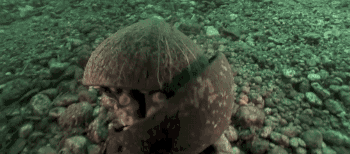
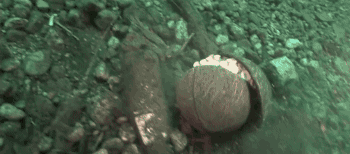
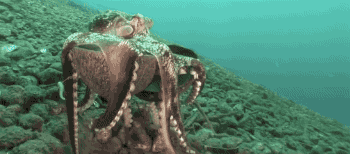
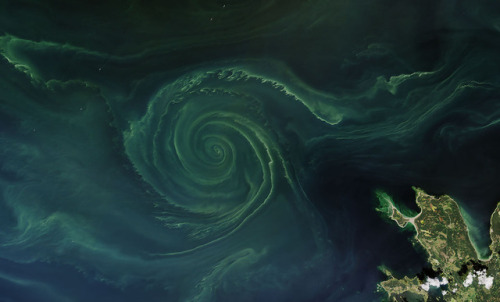
Blooms in the Baltic
Every summer, phytoplankton – microscopic plant-like organisms – spread across the North Atlantic, with blooms spanning hundreds and sometimes thousands of miles. Nutrient-rich, cooler waters tend to promote more growth among marine plants and phytoplankton than is found in tropical waters. Blooms this summer off Scandinavia seem to be particularly intense.
On July 18, 2018, the Operational Land Imager (OLI) on Landsat 8 acquired a natural-color image of a swirling green phytoplankton bloom in the Gulf of Finland, a section of the Baltic Sea. Note how the phytoplankton trace the edges of a vortex; it is possible that this ocean eddy is pumping up nutrients from the depths.
Though it is impossible to know the phytoplankton type without sampling the water, three decades of satellite observations suggest that these green blooms are likely to be cyanobacteria (blue-green algae), an ancient type of marine bacteria that capture and store solar energy through photosynthesis (like plants).
In recent years, the proliferation of algae blooms in the Baltic Sea has led to the regular appearance of “dead zones” in the basin. Phytoplankton and cyanobacteria consume the abundant nutrients in the Baltic ¬and deplete the oxygen. According to researchers from Finland’s University of Turku, the dead zone this year is estimated to span about 70,000 square kilometers (27,000 square miles).
Read more: https://go.nasa.gov/2uLK4aZ
Make sure to follow us on Tumblr for your regular dose of space: http://nasa.tumblr.com.

It may be winter in the Northern Hemisphere, but down in Antarctica, it’s currently summertime. This humpback whale migrated south to feast on the plentiful krill along the West Antarctic Peninsula.
Credit: © Ari Friedlaender











Park with large spherical rocks. Mangrove and beach in front of the resort. Our tent. The crocodiles underneath the bridge. (I took all pictures but the ones of the mangrove and the beach)
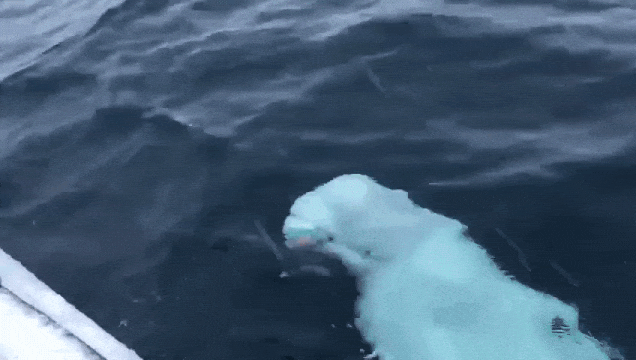
Friendly Beluga Whale Plays Fetch With Crew of a South African Ship Using a 2019 Rugby World Cup Ball




It’s the biologists turn
Having recently shared images from the Nikon Small World (see http://bit.ly/2xQdOHd) and the Insight Astronomy Photographer of the Year 2017 awards (see http://bit.ly/2ipNvkn), here are some photos from the Royal Society of Biology’s 2017 Photographer of the Year and Young Photographer of the Year competitions in a week of the year that seems to have all these events announcing their honours more or less simultaneously.
Keep reading

“Yes, hello, are you aware that it’s Sea Turtle Week?"
This endangered hawksbill turtle wants to be sure you know! Hawksbills are just one of several species of sea turtle found within the waters of Hawaiian Islands Humpback Whale National Marine Sanctuary. Look closely and you can see a GPS-linked satellite tag on its shell. This tag helps NOAA researchers track its movements, so we can better understand which habitats are critical for hawksbill recovery.
(Photo: Don McLeish/NOAA)
[Image description: A close-up of a hawksbill turtle that is looking directly at the camera. A small GPS tag is attached to its shell.]
Changing main blog now. Everything before this is my study abroad experience in Costa Rica
-
 hello-grandcollectionpainter liked this · 6 years ago
hello-grandcollectionpainter liked this · 6 years ago -
 wiedzmin-sandro reblogged this · 6 years ago
wiedzmin-sandro reblogged this · 6 years ago -
 2manyzoombinis2count reblogged this · 6 years ago
2manyzoombinis2count reblogged this · 6 years ago -
 2manyzoombinis2count liked this · 6 years ago
2manyzoombinis2count liked this · 6 years ago -
 candy-gecko reblogged this · 6 years ago
candy-gecko reblogged this · 6 years ago -
 silverandsunflowers reblogged this · 6 years ago
silverandsunflowers reblogged this · 6 years ago -
 tapirspit liked this · 6 years ago
tapirspit liked this · 6 years ago -
 clownspouse reblogged this · 6 years ago
clownspouse reblogged this · 6 years ago -
 clownspouse liked this · 6 years ago
clownspouse liked this · 6 years ago -
 darling-princee-archive liked this · 6 years ago
darling-princee-archive liked this · 6 years ago -
 climate-changing liked this · 6 years ago
climate-changing liked this · 6 years ago -
 highlyrelatable reblogged this · 6 years ago
highlyrelatable reblogged this · 6 years ago -
 highlyrelatable liked this · 6 years ago
highlyrelatable liked this · 6 years ago -
 unlikelyeggpandashark reblogged this · 6 years ago
unlikelyeggpandashark reblogged this · 6 years ago -
 unlikelyeggpandashark liked this · 6 years ago
unlikelyeggpandashark liked this · 6 years ago -
 sotnoss liked this · 6 years ago
sotnoss liked this · 6 years ago -
 thatcraxygurrl liked this · 6 years ago
thatcraxygurrl liked this · 6 years ago -
 hiskidsarerunning reblogged this · 6 years ago
hiskidsarerunning reblogged this · 6 years ago -
 chromium-siren liked this · 6 years ago
chromium-siren liked this · 6 years ago -
 annarcana reblogged this · 6 years ago
annarcana reblogged this · 6 years ago -
 annarcana liked this · 6 years ago
annarcana liked this · 6 years ago -
 gasparo73 reblogged this · 6 years ago
gasparo73 reblogged this · 6 years ago -
 gasparo73 liked this · 6 years ago
gasparo73 liked this · 6 years ago -
 deepfootballovergeek liked this · 6 years ago
deepfootballovergeek liked this · 6 years ago -
 polymathmadness reblogged this · 6 years ago
polymathmadness reblogged this · 6 years ago -
 wiedzmin-sandro liked this · 6 years ago
wiedzmin-sandro liked this · 6 years ago -
 silverandsunflowers liked this · 6 years ago
silverandsunflowers liked this · 6 years ago -
 nelson-and-murdock reblogged this · 6 years ago
nelson-and-murdock reblogged this · 6 years ago -
 mxselfdestruct liked this · 6 years ago
mxselfdestruct liked this · 6 years ago -
 fallfeatherspony liked this · 6 years ago
fallfeatherspony liked this · 6 years ago -
 randomthoughtsin liked this · 6 years ago
randomthoughtsin liked this · 6 years ago -
 mary-ploppins liked this · 6 years ago
mary-ploppins liked this · 6 years ago -
 freaky-deaky-dreams reblogged this · 6 years ago
freaky-deaky-dreams reblogged this · 6 years ago -
 eveandthemoon liked this · 6 years ago
eveandthemoon liked this · 6 years ago -
 lordquinton reblogged this · 6 years ago
lordquinton reblogged this · 6 years ago -
 lordquinton liked this · 6 years ago
lordquinton liked this · 6 years ago -
 combustionwaltz reblogged this · 6 years ago
combustionwaltz reblogged this · 6 years ago -
 cayday reblogged this · 6 years ago
cayday reblogged this · 6 years ago -
 squiddoodle reblogged this · 6 years ago
squiddoodle reblogged this · 6 years ago -
 boobachu reblogged this · 6 years ago
boobachu reblogged this · 6 years ago -
 simplyphytoplankton reblogged this · 6 years ago
simplyphytoplankton reblogged this · 6 years ago -
 howlfromthecore reblogged this · 6 years ago
howlfromthecore reblogged this · 6 years ago -
 ca1iban liked this · 6 years ago
ca1iban liked this · 6 years ago -
 eopederson liked this · 6 years ago
eopederson liked this · 6 years ago -
 galigyal reblogged this · 6 years ago
galigyal reblogged this · 6 years ago

Blog dedicted to phytoplankton. Phytoplankton are microscopic organisms that are responsible for half of the photosynthesis that occurs on Earth. Oh, and they look like art... Follow to learn more about these amazing litter critters! Caution: Will share other ocean science posts!Run by an oceanographer and phytoplankton expert. Currently a postdoctoral researcher.Profile image: False Colored SEM image of Emiliania huxleyi, a coccolithophore, and the subject of my doctoral work. Credit: Steve Gschmeissner/ Science Photo Library/ Getty ImagesHeader image: Satellite image of a phytoplankton bloom off the Alaskan Coast, in the Chukchi SeaCredit: NASA image by Norman Kuring/NASA's Ocean Color Web https://earthobservatory.nasa.gov/images/92412/churning-in-the-chukchi-sea
158 posts